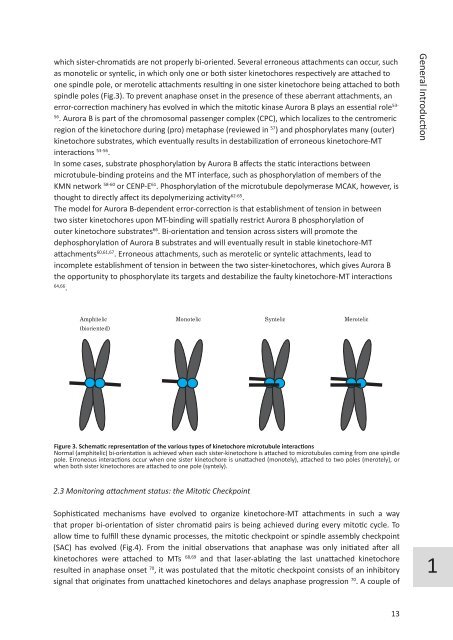Chromosome segregation errors: a double-edged sword - TI Pharma
Chromosome segregation errors: a double-edged sword - TI Pharma
Chromosome segregation errors: a double-edged sword - TI Pharma
You also want an ePaper? Increase the reach of your titles
YUMPU automatically turns print PDFs into web optimized ePapers that Google loves.
which sister-chromatids are not properly bi-oriented. Several erroneous attachments can occur, such<br />
as monotelic or syntelic, in which only one or both sister kinetochores respectively are attached to<br />
one spindle pole, or merotelic attachments resulting in one sister kinetochore being attached to both<br />
spindle poles (Fig.3). To prevent anaphase onset in the presence of these aberrant attachments, an<br />
error-correction machinery has evolved in which the mitotic kinase Aurora B plays an essential role53- 56 . Aurora B is part of the chromosomal passenger complex (CPC), which localizes to the centromeric<br />
region of the kinetochore during (pro) metaphase (reviewed in 57 ) and phosphorylates many (outer)<br />
kinetochore substrates, which eventually results in destabilization of erroneous kinetochore-MT<br />
interactions 53-56 .<br />
In some cases, substrate phosphorylation by Aurora B affects the static interactions between<br />
microtubule-binding proteins and the MT interface, such as phosphorylation of members of the<br />
KMN network 58-60 or CENP-E61 . Phosphorylation of the microtubule depolymerase MCAK, however, is<br />
thought to directly affect its depolymerizing activity62-65 .<br />
The model for Aurora B-dependent error-correction is that establishment of tension in between<br />
two sister kinetochores upon MT-binding will spatially restrict Aurora B phosphorylation of<br />
outer kinetochore substrates66 . Bi-orientation and tension across sisters will promote the<br />
dephosphorylation of Aurora B substrates and will eventually result in stable kinetochore-MT<br />
attachments60,61,67 . Erroneous attachments, such as merotelic or syntelic attachments, lead to<br />
incomplete establishment of tension in between the two sister-kinetochores, which gives Aurora B<br />
the opportunity to phosphorylate its targets and destabilize the faulty kinetochore-MT interactions<br />
64,66 .<br />
Amphitelic<br />
(bioriented)<br />
Monotelic Syntelic<br />
Merotelic<br />
Figure 3. Schematic representation of the various types of kinetochore microtubule interactions<br />
Normal (amphitelic) bi-orientation is achieved when each sister-kinetochore is attached to microtubules coming from one spindle<br />
pole. Erroneous interactions occur when one sister kinetochore is unattached (monotely), attached to two poles (merotely), or<br />
when both sister kinetochores are attached to one pole (syntely).<br />
2.3 Monitoring attachment status: the Mitotic Checkpoint<br />
Sophisticated mechanisms have evolved to organize kinetochore-MT attachments in such a way<br />
that proper bi-orientation of sister chromatid pairs is being achieved during every mitotic cycle. To<br />
allow time to fulfill these dynamic processes, the mitotic checkpoint or spindle assembly checkpoint<br />
(SAC) has evolved (Fig.4). From the initial observations that anaphase was only initiated after all<br />
kinetochores were attached to MTs 68,69 and that laser-ablating the last unattached kinetochore<br />
resulted in anaphase onset 70 , it was postulated that the mitotic checkpoint consists of an inhibitory<br />
signal that originates from unattached kinetochores and delays anaphase progression 70 . A couple of<br />
13<br />
General Introduction 1













